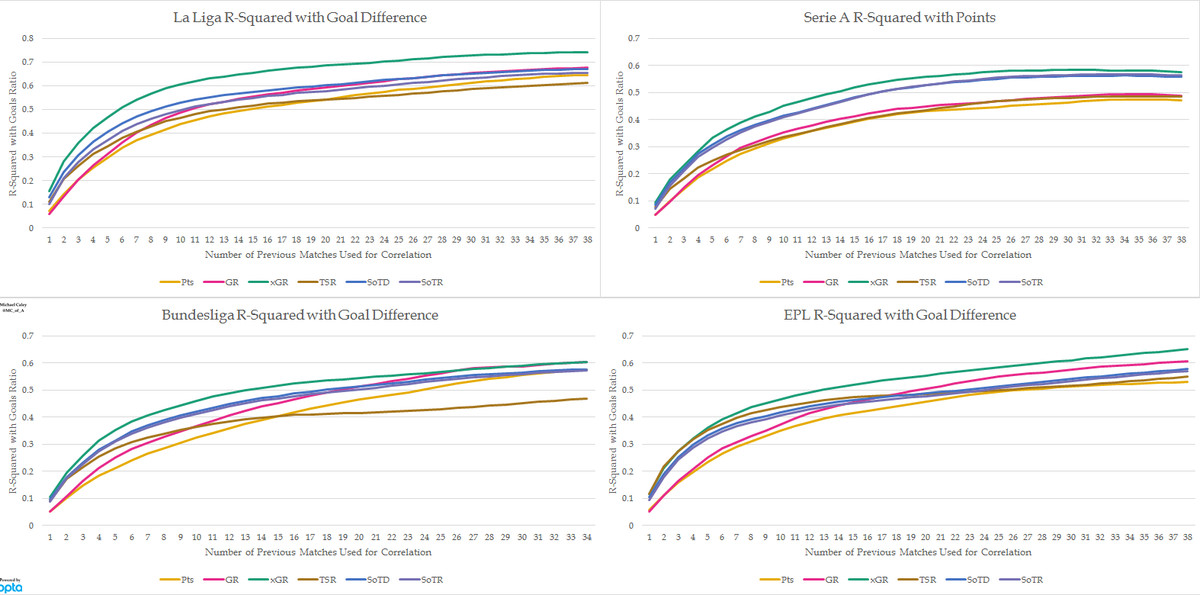
Expected goals factor Analysis and its implications in live soccer betting.
Expected Goals factor: accurate or just another version of the Odds?
Sports Betting is an important source of cash stream. In fact, the amount of cash that flows through the system is around $100 billion (sum of waged stakes through the six popular sports betting companies).
In this stream, soccer betting contributes a percentage of about 40%. The fact is, the process requires a good understanding of the odds and the expected goals factor. Both parameters result from the diagnosis run by the bookmakers. However, each parameter has a particular significance and it is used in a particular way. The odds, usually, serve to calculate the probability of occurrence of an event as well as the sum to win. The expected goals factor refers to something else which may be as important as the overall odds.
The expected goals factor differs from the regular odds by the significance, the behaviour, and the calculation. However, both elements are the outputs of the data processing. The algorithm runs the data processing and then discloses the results to the public in numerical form. They may use the same inputs but the outputs are read differently. Indeed, they have their importance in the live soccer betting experience.
Subfactors
Besides, the expected goals factor, or commonly the “xG”, designates a group of sub-factors notably the expected goals in 90 minutes, and the penalty or non-penalty goals. There are several elements in the group. Each is calculated upon definite data that the bookmakers collect and analyze. However, bettors can perform the analysis but they will need to collect the data themselves; the process has a great chance to be incomplete and so will be the analysis.
On the other hand, to use the expected goals in betting requires you to understand the implication of such statistics on the decision. Indeed, this factor has a determining impact on the way the match will evolve. This factor is the event that shall come next to every shot, to every scored goal, and to every missed opportunity.
Help in betting?
As the matter of fact, the xG can stand for a betting helper. It relates to and influences an important category of probable events which are the scored goals. It also describes their implication on the overall match progression, as well as the outcomes of the betting rounds. There will be a large list of data that undergoes statistical calculations.
It includes a great number of parameters with many values. They result from rigorous research over the history of the involved teams. This research will help to trace the tendencies that a particular team will exhibit during the match in response to a list of factors. These tendencies are precisely about the ability to score many goals.
Actually, the xG calculation and formulation reinforces the set of data regarding the running match, since live soccer betting is performed during the match. The odds may change at any time and in no time, the xG is also susceptible to change rapidly. This leads to the question that goes like this: Is betting on live soccer using the expected goals factor more secure than betting by reading the odds?
Or is it wise to consider both elements to improve the winning chances?
Defining the Expected Goals factor:
The first time the term expected Goals was employed was in a certain paper that dealt with something that has nothing to do with sports betting. In fact, the term describes the performance of teams on artificial grass considering the localization of the match (Home or Away). The paper referred to the influence of the pitch on the performance by the rate of scored goals versus the expected goals.
The fact is, Expected Goals factor is a set of statistic measurements describing the probability of scoring goals in given circumstances. It is important to consider that there are several situations that are recurrent but with different outcomes. The influence of the first considered factor, which is the artificial pitch, has indeed more than one implication on the player's performance and therefore on the overall game.
Besides, The xG factor seems to depend on several others factors. In fact, the calculation of xG used some mathematical equations. The inputs are, definitely, the values of the several variables in the equations, the results, which is indeed the xG rates, express the interdependence of the elements.
On the other hand, the Expected Goals factor is to read carefully. It is written in a different way from the odds, and it is to read and understand in a different way as well.
Tools to calculate the xG factor:
The xG factor hides a list of correlated parameters susceptible to modelling the tendencies of the match. The expected goals factor is the result of applying statistical theories to a wide range of data. These data are mainly related to the shots. Then there is the creation of the model that describes the tendencies of the team to create similar circumstances. The properties related to the shots are detailed in the following lines. The calculation will furnish the basic inputs for building the xG models.
- shot nature:
shot nature designates whether the ball is moving or it is still. It regroups free-kicks, corners, and penalties for the still ball and the shots during attacks for the moving ball.
- shot position:
The shot position designates two factors: the distance from the cage and the angle regarding the axis relating the two penalty spots. This factor is considered after knowing the nature of the shot. It adds its an important impact on the outcomes of the calculations.
- shot direction:
This parameter is determined regarding the cage orientation. In other words, the direction of the shot is to the left or to the right horizontally; high or low vertically.
- shot constraints:
This parameter can be described as the number of players, from both teams, is disputing the ball. It describes the number of players of the offensive team against the number of players of the defensive team. This factor can be determinant, but it is the result of the team strategy and game plan.
Types of Expected Goals factor:
This factor is distinguished in some sub-classes. The fact is, goals can be scored in more than one way and each way has particular constraints. Definitely, this adds more data to collect when trying to determine the xG factor related to a match, a team, or a player but it enhances the accuracy of the obtained values.
The following list regroups the most common types of expected goals. Nonetheless, there are some other variants that can represent a detailed description of the factor. They do not stand as separate forms of the xG since they fuse very well with the common categories.
- The expected goals per 90:
this global term designates the number of goals a team or a player may score during a particular match. It emphasizes the 90 minutes of the match. it doesn't consider the extra time. it includes all the scored goals regardless of their nature or type. It can represent the sum of goals scored by both teams during the match as well as the scored and goals accepted.
- The non-penalty expected goals:
This category excludes the penalty goals. This is also calculated for both teams during the whole match, or it can be calculated for a single team. It is possible to make the calculation for the most scoring players.
- The expected goals against/ for:
The two variants of this xG describe the likelihood of the team to accept goals and the likelihood to score goals. The teams have different chances of scoring, and then the calculation of the xG factor will consider the effects of the confronted (compared) global xG.
Calculation of the xG factor:
Actually, the likelihood of the considered team to score goals is the likelihood of this team to conclude an opportunity. Indeed, depending on shot properties the player has the chance to score a goal with a probability p.
Starting with shot nature, the still balls include penalties, corners, and free-kicks. The analysis of the whole history of both teams will help to determine the overall factors. The private xGs will measure the factors related to the respective teams.
For example, during the period T, In the league L, there were Nf free-kicks, among which nf were successful.
The success rate would be: nf / Nf x 100= r %.
In the same league, the team has a success rate rA, and team B has a success rate rB. The latest rates designate the overall free-kicks obtained by team A, the free-kicks against team B, and scored free-kicks against team B. The success rate of the next match bringing face to face the two teams is therefore calculated using probability theories.
In fact, the calculation of the xG requires the compilation of as much data as you can get about the scored goals tendencies. Of course, the data should be categorised according to a definite classification in order to perform the most accurate calculations.
The models of the expected goals parameter:
The simple calculation of the xG seems to describe a simple model of the process. In fact, literature uses more than one model to represent the expected goals factor. For convenience, it is better to look for reviews of the best models, which are probably the most impactful and the most accurate one. The following lines would deal with the modelling in general.
In fact, the xG factor describes a certain complexity of the inputs to involve in the calculation process. In other words, it describes the way on which the calculation algorithms will treat the compiled and refined data.
The xG model o Paul Riley is the most famous model. it fragments the pitch area into smaller squares. The process assigns definite probabilities for shots attempted from within the squares. Obviously, the xG value is already present in some way within the calculation. Any attempted shot from the square will have the assigned value.
Literature proposes other models and each author can propose a distinguished presentation of the model. The fact is, they can use custom representations as betting strategies. The final result is what matters; the model is effective as long as it leads to good betting experiences.
The implication of Expected Goals factor:
Understanding the calculation process of the expected goals factor is not enough but it can help how to use it. It is important to know how to read the calculated factor. In fact, the xG has two kinds of implications: Quantitative implication and qualitative implication.
The quantitative implication of the xG:
Quantitatively, the xG parameter requires a few amounts of entries. These entries describe, each, the several considered variables used to calculate the xG. In fact, considering Paul Riley's model, the value to assign to each square is the data related to the shot from this location. Each actor, whether it is a team or a single player, carries the same amount of data. In other words, the data are just to describe the shots, and definitely, the properties of the shots. To compare with the odds, this factor doesn’t require comprehending the infinite details involved in the match (teams composition, player’s health, mentality…)
The qualitative implication of the xG:
Obviously, the models representing the xG factor focus on the shot properties regardless of the other involved factors. In fact, the other factors are present in one way or another since they contribute to determining the quality of the shots. Amazingly, this reduction has improved the predictive success of the xG method. The Understat.com offers the best illustrations of the validity of the xGs method. Against the odds, the xG factor seems to have a steady and stable evolution.
Using the expected goals factor in the live betting:
The use of the expected goals factor in live soccer betting has increased the success rate of the bettors. Nonetheless, the betting strategy would rather include the odds. This indicates that the use of more than one parameter in betting is helpful but not an exclusive guarantee. It is possible that the xG hides a conflictual side with the betting odds. This is in compliance with the odds definition in the literature.
In fact, Combining the two parameters help to resolve the noticed conflict. Mathematically, the two probabilities add their significance and become an important index. In the case of the obvious difference between the two parameters, bettors tend to prioritize the xG factor. It is hardly believable that the bookmakers can disclose values that help you win easily.
Besides, the final prediction is equal to the comparison of the xGs of the two playing teams. This leads to say the differential xG will then represent the predictable final result. The xG factor seems to reduce the betting session to predicting a few numbers of events. This behaviour is definitely different from the basic definition of the odds.
The odds at this point affect the xGs calculation. In fact, they influence the inputs and therefore they may modify the result. The probabilistic nature of the two combined parameters would reduce the odds of unpredictable surprises. The expected goals factor will then describe the predictable events.
Conclusion:
The expected goals factor comes to add a really interesting feature to the betting experience. In fact, this factor is based on the study of the shots. The probability equations will then, and mathematically, determine the likelihood for scoring a certain number of goals. This scoring susceptibility can describe several aspects; from scoring goals to accepting goals. The likelihood of scoring goals works well with the odds that fluctuate with almost all the events that occur during the match. Yet, it suffices the modification of the odds to change the outcomes. There might be a dependency between the odds and the xG factor.
In fact, the xG factor defines the success of the scoring attempts which generally are more active or passive during the match. The activity level of these attempts can be in response to some particular events during the match.
The expected goals parameter is flexible to the point that every author has a particular model that represents the calculation he performed to build his private xG. Nonetheless, it is safer to adopt a known model in order to obtain proven results.
Finally, the expected goals factor and the odds seem to work well together. Predicting the final results would be accurate when you proceed by the right combinations. The process will be effective if you combine the xGs related to the teams or to the players with the right odds calculated by the bookmaker algorithms.
You may also like
Categories
- Recent
- Tutorials
- Bookmakers
- Tipsters and tipping sites
- Arbitrage and betting tools
- Transfer news
- Football in general
- Betting in general
- International Football Tournaments
- Sports
Popular posts
 How to spot a football fix?
How to spot a football fix?
![Statistics Tool [Tutorial 4] How to work on the Backtesting feature?](/newsImages/89x89/ana-graph-1604054958.jpg) Statistics Tool [Tutorial 4] How to work on the Backtesting feature?
Statistics Tool [Tutorial 4] How to work on the Backtesting feature?
![Spreadsheet Features [Tutorial 3]](/newsImages/89x89/mainpic-1593606948.png) Spreadsheet Features [Tutorial 3]
Spreadsheet Features [Tutorial 3]
![Notifications Backtesting [Tutorial 2] - Unique feature that nobody has](/newsImages/89x89/backtestss-1586000233.png) Notifications Backtesting [Tutorial 2] - Unique feature that nobody has
Notifications Backtesting [Tutorial 2] - Unique feature that nobody has







